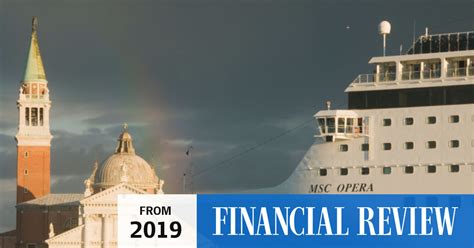
Tourism backlash is escalating in the European city of Venice, Italy, as residents voice increasing frustration over unsustainable tourist levels, leading to demonstrations and calls for a reduction in visitor numbers to preserve the city’s cultural heritage and quality of life for locals.
Venice, a UNESCO World Heritage site renowned for its canals, architecture, and unique cultural identity, is grappling with the adverse effects of mass tourism, including overcrowding, rising living costs, and environmental degradation. The situation has prompted a growing movement among residents who feel that the city is being overwhelmed by visitors, threatening its very existence as a living, breathing community.
The frustrations have manifested in various forms, including protests and demonstrations aimed at raising awareness of the issue and pressuring local authorities to take action. These actions reflect a deeper sentiment among Venetians who believe that the current model of tourism is unsustainable and detrimental to the city’s long-term well-being. Activists and concerned citizens are advocating for policies that prioritize the needs of residents and promote a more balanced and responsible approach to tourism.
One of the key concerns is the sheer volume of tourists that Venice attracts, particularly during peak seasons. The influx of visitors puts a strain on the city’s infrastructure, including its public transportation system, waste management services, and water supply. Additionally, the increased demand for accommodation and services has driven up prices, making it difficult for locals to afford to live in the city. The character of Venice is also being altered, with traditional businesses being replaced by souvenir shops and fast-food outlets catering to tourists.
“Venice is becoming a theme park,” said Matteo Secchi, a Venetian resident and activist who spoke to Yahoo. “We’re losing our identity, our traditions, and our way of life.”
The situation in Venice reflects a broader trend of growing anti-tourism sentiment in many popular destinations around the world. As the number of international travelers continues to rise, cities and regions are struggling to manage the impacts of mass tourism, leading to tensions between residents and visitors. Issues such as overcrowding, environmental damage, and the displacement of local communities are becoming increasingly common, prompting calls for a more sustainable and responsible approach to tourism development.
The Roots of the Crisis
Venice’s vulnerability to overtourism is rooted in its unique geographical and historical context. As an island city with limited land area and a fragile ecosystem, Venice is particularly susceptible to the negative impacts of mass tourism. The city’s infrastructure, which was originally designed for a much smaller population, is struggling to cope with the demands of millions of visitors each year.
The rise of budget airlines and online travel platforms has also contributed to the problem, making it easier and more affordable for people to visit Venice. This has led to a surge in short-term trips, with many tourists spending only a few hours or a day in the city, contributing to overcrowding and congestion.
The Impact on Residents
The impact of overtourism on Venetian residents is multifaceted. One of the most pressing issues is the rising cost of living, particularly housing. As demand for accommodation increases, rents and property prices have skyrocketed, making it difficult for locals to find affordable housing. Many Venetians have been forced to move out of the city center, leading to a decline in the resident population.
The changing character of Venice is also a major concern for residents. As traditional businesses are replaced by tourist-oriented shops and restaurants, the city is losing its authenticity and cultural identity. Many Venetians feel that their city is being transformed into a playground for tourists, with little regard for the needs and interests of the local community.
“We’re not against tourism,” said Maria Rossi, a lifelong Venetian resident. “But we want a tourism that respects our city and our way of life. We want a tourism that benefits the local community, not just the big corporations.”
Proposed Solutions
In response to the growing crisis, local authorities and community groups have proposed a range of solutions aimed at managing tourism more effectively and mitigating its negative impacts. These include:
- Introducing a tourist tax: Venice has already implemented a tourist tax for overnight stays, but there are proposals to extend the tax to day-trippers as well. The revenue generated from the tax could be used to fund infrastructure improvements and support local businesses.
- Limiting the number of visitors: Some have called for stricter limits on the number of tourists allowed into the city each day, particularly during peak season. This could be achieved through a reservation system or by restricting access to certain areas of the city.
- Promoting sustainable tourism: Efforts are being made to encourage tourists to visit Venice during the off-season and to explore areas outside the city center. This would help to distribute the economic benefits of tourism more widely and reduce pressure on the most popular areas.
- Supporting local businesses: Initiatives are being launched to support traditional businesses and encourage the development of new businesses that cater to the needs of local residents. This would help to preserve the city’s cultural identity and create a more vibrant local economy.
- Raising awareness: Education campaigns are being conducted to raise awareness among tourists about the impacts of their behavior on the city and its residents. These campaigns encourage tourists to be respectful of local customs and traditions and to support sustainable businesses.
The Broader Context
The situation in Venice is not unique. Many other popular destinations around the world are facing similar challenges related to overtourism. Cities such as Barcelona, Amsterdam, and Kyoto have all experienced a surge in tourist numbers in recent years, leading to tensions between residents and visitors.
The rise of overtourism is a complex issue with no easy solutions. It requires a multi-faceted approach that takes into account the needs of both tourists and local residents. Governments, tourism operators, and community groups all have a role to play in finding sustainable solutions that protect the environment, preserve cultural heritage, and ensure a high quality of life for local communities.
The Future of Venice
The future of Venice depends on the ability of stakeholders to find a way to balance the economic benefits of tourism with the need to protect the city’s cultural heritage and ensure the well-being of its residents. This will require a shift away from the current model of mass tourism towards a more sustainable and responsible approach.
Venice has a long and rich history, and it is a city that deserves to be preserved for future generations. By working together, residents, authorities, and tourism operators can ensure that Venice remains a vibrant and thriving community for years to come.
Detailed Analysis of Overtourism Issues
Overtourism represents a critical juncture for global travel destinations, impacting not only their environmental integrity but also the socio-economic fabric of local communities. In-depth analysis reveals several facets contributing to this complex phenomenon:
- Environmental Degradation: Mass tourism often leads to increased pollution, waste generation, and strain on local resources like water and energy. In Venice, the constant flow of cruise ships and motorboats erodes the foundations of historical buildings and pollutes the canals, threatening the delicate ecosystem. The sheer volume of tourists contributes to air pollution and unsustainable waste disposal, exacerbating the city’s environmental challenges. The increased demand for souvenirs and mass-produced goods also puts a strain on resources, often supporting unsustainable production practices.
- Socio-Cultural Impacts: The influx of tourists can dilute local culture, transforming authentic traditions and businesses into commodities for tourist consumption. In Venice, traditional artisan shops are increasingly replaced by souvenir shops selling mass-produced items, diminishing the city’s unique character. The constant presence of tourists can also lead to a loss of privacy and a sense of alienation among residents, disrupting social cohesion. The commodification of local culture can also lead to the erosion of traditional values and practices.
- Economic Disparities: While tourism can bring economic benefits, these are often unevenly distributed, with large corporations and foreign investors capturing the majority of profits. Local businesses may struggle to compete with international chains, leading to job losses and economic marginalization. The increased demand for accommodation and services drives up prices, making it difficult for locals to afford basic necessities like housing and food. The seasonal nature of tourism can also create economic instability, with periods of high employment followed by periods of unemployment.
- Infrastructure Strain: The increased demand on infrastructure, including transportation, sanitation, and utilities, can overwhelm local systems, leading to breakdowns and service disruptions. Venice’s narrow streets and canals are often congested with tourists, making it difficult for residents to move around the city. The increased demand for water and energy puts a strain on the city’s resources, leading to shortages and rationing. The city’s waste management system struggles to cope with the volume of garbage generated by tourists, leading to unsanitary conditions.
- Loss of Authenticity: The transformation of local culture into a tourist spectacle can lead to a loss of authenticity and a sense of placelessness. Traditional neighborhoods are gentrified to cater to tourists, displacing local residents and businesses. Historical landmarks are overrun with visitors, making it difficult to appreciate their cultural significance. The city’s unique character is diluted by the proliferation of generic tourist attractions and experiences.
Comparative Case Studies: Lessons from Other Overwhelmed Destinations
Examining how other cities and regions have tackled overtourism offers valuable insights and potential strategies for Venice:
- Barcelona, Spain: Faced with similar issues of overcrowding and resident displacement, Barcelona has implemented measures like limiting new hotel licenses, promoting alternative tourist routes, and cracking down on illegal rentals. The city has also launched campaigns to encourage responsible tourist behavior and promote respect for local culture. While these measures have had some success, Barcelona continues to grapple with the challenges of overtourism, highlighting the need for ongoing monitoring and adaptation.
- Amsterdam, Netherlands: Amsterdam has adopted a more aggressive approach, including increasing tourist taxes, banning new souvenir shops in the city center, and launching campaigns to discourage “nuisance tourism.” The city is also investing in infrastructure improvements to manage tourist flows and improve the quality of life for residents. Amsterdam’s experience demonstrates the importance of bold and decisive action in addressing overtourism.
- Kyoto, Japan: Kyoto has focused on promoting sustainable tourism practices, such as encouraging visitors to explore lesser-known areas, supporting local businesses, and respecting local customs. The city has also implemented measures to manage crowds at popular attractions and promote off-season travel. Kyoto’s approach highlights the importance of cultural sensitivity and community engagement in managing tourism.
- Iceland: Faced with a rapid increase in tourist numbers in recent years, Iceland has implemented measures such as increasing taxes on tourism-related activities, investing in infrastructure improvements, and promoting responsible travel practices. The country has also launched campaigns to protect its fragile natural environment and educate visitors about the importance of sustainability. Iceland’s experience demonstrates the need for proactive planning and investment in managing tourism growth.
- Dubrovnik, Croatia: The coastal city has started limiting the number of cruise ships that can dock each day. It has also installed surveillance cameras to monitor pedestrian traffic and reroute visitors when necessary, aiming to ease congestion within the historic old town.
The Role of Technology in Managing Tourism
Technology can play a crucial role in managing tourism more effectively and mitigating its negative impacts. Some potential applications include:
- Data Analytics: Analyzing data on tourist flows, spending patterns, and behavior can help authorities to identify hotspots, predict future trends, and develop targeted interventions.
- Smart City Technologies: Implementing smart city technologies such as intelligent traffic management systems, waste management sensors, and energy-efficient infrastructure can help to improve the efficiency and sustainability of tourism.
- Mobile Apps: Developing mobile apps that provide information on alternative attractions, public transportation options, and local businesses can help to disperse tourists and promote sustainable travel practices.
- Virtual Reality: Creating virtual reality experiences that allow tourists to explore cultural heritage sites and natural landscapes remotely can help to reduce the physical impact of tourism.
- Online Booking Platforms: Using online booking platforms to manage reservations, control access to popular attractions, and promote off-season travel can help to distribute tourist flows more evenly.
Community-Based Tourism: A Path Towards Sustainability
Community-based tourism (CBT) offers a promising alternative to mass tourism, empowering local communities to control and benefit from tourism development. CBT initiatives typically involve:
- Local Ownership: Ensuring that local communities have ownership and control over tourism businesses and resources.
- Benefit Sharing: Distributing the economic benefits of tourism equitably among community members.
- Cultural Preservation: Promoting the preservation and celebration of local culture and traditions.
- Environmental Protection: Minimizing the environmental impact of tourism and promoting sustainable practices.
- Community Participation: Engaging community members in the planning, management, and monitoring of tourism activities.
By empowering local communities to manage their own tourism resources, CBT can help to create more sustainable and equitable tourism systems that benefit both visitors and residents.
Policy Recommendations for Sustainable Tourism in Venice
To address the challenges of overtourism in Venice, policymakers should consider the following recommendations:
- Implement a comprehensive tourism management plan: This plan should include clear goals, objectives, and strategies for managing tourism sustainably, with input from all stakeholders.
- Strengthen regulations and enforcement: Regulations related to tourist accommodation, businesses, and activities should be strengthened and enforced effectively.
- Invest in infrastructure improvements: Investments should be made in infrastructure improvements to manage tourist flows, improve public transportation, and enhance the quality of life for residents.
- Promote sustainable tourism practices: Tourists should be encouraged to adopt sustainable travel practices, such as using public transportation, supporting local businesses, and respecting local customs.
- Engage the local community: Local residents should be actively involved in the planning, management, and monitoring of tourism development.
- Diversify the economy: Efforts should be made to diversify the local economy and reduce dependence on tourism.
- Monitor and evaluate progress: The effectiveness of tourism management policies should be regularly monitored and evaluated, with adjustments made as needed.
The Ethical Considerations of Visiting Overcrowded Destinations
Travelers also bear a responsibility to consider the ethical implications of visiting overcrowded destinations. Responsible travelers should:
- Choose to visit during the off-season: Traveling during the off-season can help to reduce overcrowding and support local businesses during slower periods.
- Explore lesser-known areas: Venturing beyond the main tourist attractions can help to disperse visitors and discover hidden gems.
- Support local businesses: Patronizing local businesses and restaurants can help to support the local economy and preserve cultural traditions.
- Respect local customs: Being respectful of local customs and traditions can help to foster positive relationships with residents.
- Minimize environmental impact: Reducing waste, conserving water, and using public transportation can help to minimize the environmental impact of tourism.
- Educate themselves about the destination: Learning about the local culture, history, and environment can help to foster a deeper appreciation for the destination.
By making conscious choices and adopting responsible travel practices, tourists can contribute to the sustainability of popular destinations and ensure that they remain vibrant and thriving communities for years to come.
Conclusion: A Call for Collective Action
The challenges of overtourism in Venice and other popular destinations require a collective effort from governments, tourism operators, local communities, and tourists themselves. By working together to implement sustainable tourism practices, we can protect the environment, preserve cultural heritage, and ensure that tourism benefits both visitors and residents. The future of Venice, and countless other cherished destinations, depends on our ability to act responsibly and create a more sustainable future for travel. Only through collaborative and conscientious approaches can we hope to preserve these unique places for generations to come. The growing anti-tourism sentiment serves as a crucial wake-up call, urging a reevaluation of current tourism models and a shift towards practices that prioritize sustainability, community well-being, and the preservation of cultural heritage. The future hinges on the ability to transform tourism from a potential threat into a positive force for change.
Frequently Asked Questions (FAQs)
1. Why are Venetians protesting against tourism?
Venetians are protesting due to the overwhelming number of tourists, which leads to overcrowding, rising living costs, damage to infrastructure, and the loss of authentic Venetian culture. As Matteo Secchi stated, residents feel Venice is “becoming a theme park,” losing its identity. The influx of tourists strains resources and displaces locals, making it difficult to maintain their way of life.
2. What are some proposed solutions to manage overtourism in Venice?
Proposed solutions include introducing a tourist tax for day-trippers, limiting the number of visitors, promoting sustainable tourism, supporting local businesses, and raising awareness among tourists about responsible behavior. The aim is to balance the economic benefits of tourism with the need to protect the city and its residents.
3. How does overtourism impact the environment in Venice?
Overtourism leads to increased pollution from cruise ships and motorboats, eroding building foundations and polluting canals. Waste management struggles to cope with the volume of garbage, and the demand for resources like water and energy puts a strain on the city’s infrastructure.
4. What can tourists do to be more responsible when visiting Venice?
Tourists can visit during the off-season, explore lesser-known areas, support local businesses, respect local customs, minimize their environmental impact, and educate themselves about the destination. Making conscious choices can help reduce the negative impacts of tourism.
5. Is Venice the only city facing problems with overtourism?
No, many cities worldwide, such as Barcelona, Amsterdam, Kyoto, and Dubrovnik, are facing similar challenges related to overtourism. These cities are exploring various measures to manage tourism more effectively and mitigate its negative impacts, showing that the issue is a global concern.









